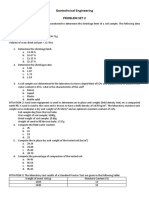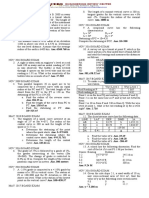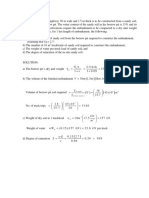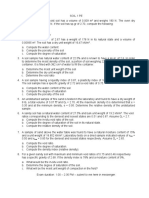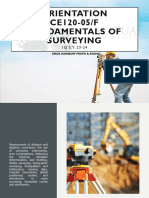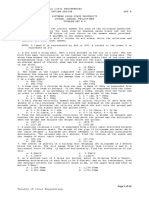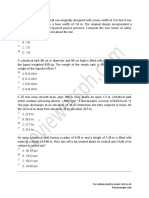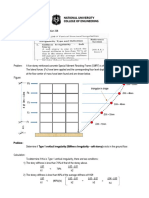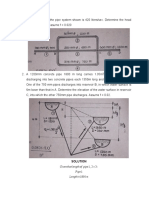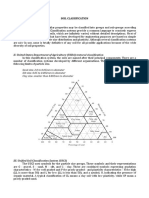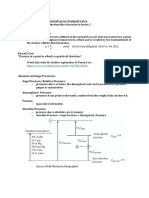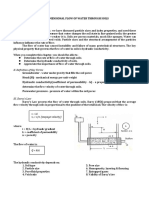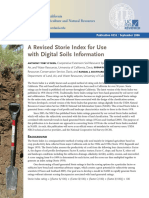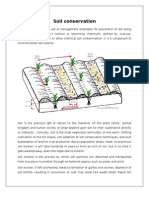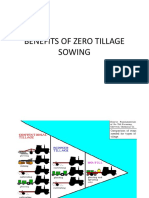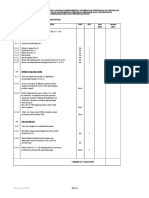Problem No: 1: Submitted To
Problem No: 1: Submitted To
Uploaded by
Light HouseCopyright:
Available Formats
Problem No: 1: Submitted To
Problem No: 1: Submitted To
Uploaded by
Light HouseOriginal Title
Copyright
Available Formats
Share this document
Did you find this document useful?
Is this content inappropriate?
Copyright:
Available Formats
Problem No: 1: Submitted To
Problem No: 1: Submitted To
Uploaded by
Light HouseCopyright:
Available Formats
PROBLEM NO: 1
1) A soil has the following particle-size distribution:
Gravel = 20%
Sand = 10%
Silt = 30%
Clay = 40%
Classify the soil according to USDA textural classification system.
SOLUTION:
1.) Modified % Sand = %sand/(100%-%gravel) = 10%/(100%-20%) = 12.5%
2.) Modified % Silt = %silt/(100%-%gravel) = 30%/(100%-20%) = 37.5%
3.) Modified % Clay = %clay/(100%-%gravel) = 10%/(100%-20%) = 50%
The classification for the soil sample is Clay.
SUBMITTED BY: SUBMITTED TO: COURSE NAME: PLATE NO. 2
GENESIS K. LUEGO ENGR. JOMAR TAGALOG GEOTECHNICAL ENGINEERING SHEET NO. 1/4
1 (LABORATORY)
BSCE 3 – A INSTRUCTOR CE-321L DATE: 07/19/21
PROBLEM NO: 2
2) From the given data, shows a sieve analysis of soil samples A, B and C.
a) Classify the soil sample A using USCS Method.
b) Classify the soil sample B using USCS Method.
c) Classify the soil sample C using USCS Method.
SOLUTION:
A.) D10=0.164; D30=0.692
Grain Size Distribution Graph D60=2.348
100 Cu = D60/D10 = 2.438/0.164
Pecent Fine by Weight
90 Cu = 14.31707317
80
70
Cc = D30/(D10*D60)
60 Cc = 0.692/(0.164*2.348)
50 Cc = 1.797066523
40
30 Cu > 4; 1 < Cc < 3
20 Type of soil A is SW well-
10
0
graded sands, gravelly sands,
100.000 10.000 1.000 0.100 0.010 0.001 little or no fines.
Grain Size in Millimeters
B.) Retained sieve no. 200 = 67% > 50% C.) Passing sieve no.200 = 63% > 50%
Coarse-Grained Soils Fine-Grained Soils
Passing sieve no. 4 = 100% > 50% LL = 47% < 50%
Sands Silts and Clays
PI = LL – PL = 46 – 29 = 17 > 7 PI = LL – PL = 47 – 24 = 23
Type of soil B is SC Clayey sands, sand- Type of soil C is CL inorganic clay of low
clay mixtures. to medium plasticity, gravelly clays, sandy
clays, silty clays, lean clays.
SUBMITTED BY: SUBMITTED TO: COURSE NAME: PLATE NO. 2
GENESIS K. LUEGO ENGR. JOMAR TAGALOG GEOTECHNICAL ENGINEERING SHEET NO. 2/4
1 (LABORATORY)
BSCE 3 – A INSTRUCTOR CE-321L DATE: 07/19/21
PROBLEM NO: 3
3) Classify the following soils by the AASHTO classification system.
a) What is the classification of Soil A?
b) What is the classification of Soil B?
c) What is the classification of Soil C?
SOLUTION:
a) Soil A is A-2-6
b) Soil B is A-2-7
c) Since PL = 23 < 30; Soil C is A-7-6
SUBMITTED BY: SUBMITTED TO: COURSE NAME: PLATE NO. 2
GENESIS K. LUEGO ENGR. JOMAR TAGALOG GEOTECHNICAL ENGINEERING SHEET NO. 3/4
1 (LABORATORY)
BSCE 3 – A INSTRUCTOR CE-321L DATE: 07/19/21
PROBLEM NO: 4
4) The following data shows the results of the sieve analysis of two soil samples A and B.
a) Which of the following most nearly gives the uniformity coefficient for soil A.
b) Classify the soil A using USCS method.
c) Classify the soil B using USCS method.
SOLUTION:
Grain Size Distribution Graph A.) D10=0.149; D30=0.84
D60=2.126666667
100
90
Cu=D60/D10
80 Cu=2.126666667/0.149
70 Cu=14.27293065
Pecent Fine by Weight
60 Cc=D30/(D10*D60)
50
40 Cc=0.84/(0.149*2.126666667)
30 Cc=2.650901517
20 B.) Cu > 4 ; 1 < Cc < 3
10
0
Type of soil A is SW well-
100.000 10.000 1.000 0.100 0.010 0.001 graded sands, gravelly sands,
Grain Size in Millimeters little or no fines.
C.) Retained sieve no. 200 = 75% > 50%; Coarse-Grained Soils
Passing sieve no. 4 = 100% > 50%; Sands
Sands with fines = 25% > 12%
Type of soil B is either SM or SC. Wherein SM is silty sands, sand-silt mixtures
and SC is clayey sands, sand-clay mixtures.
SUBMITTED BY: SUBMITTED TO: COURSE NAME: PLATE NO. 1
GENESIS K. LUEGO ENGR. JOMAR TAGALOG GEOTECHNICAL ENGINEERING SHEET NO. 4/4
1 (LABORATORY)
BSCE 3 – A INSTRUCTOR CE-321L DATE: 07/19/21
You might also like
- Plane GeometryDocument51 pagesPlane GeometryAndrew MarasiganNo ratings yet
- CE Module 28 - Rigid Retaining Wall (Answer Key)Document3 pagesCE Module 28 - Rigid Retaining Wall (Answer Key)Angelice Alliah De la CruzNo ratings yet
- X Tan G : CE Review For Nov 2022 - Hydraulics 7Document1 pageX Tan G : CE Review For Nov 2022 - Hydraulics 7JuDeNo ratings yet
- PS2 4Document10 pagesPS2 4Karl Alexis TumibayNo ratings yet
- Math 1Document1 pageMath 1adonis bibatNo ratings yet
- Lesson IV - Stresses in SoilDocument6 pagesLesson IV - Stresses in SoilLight HouseNo ratings yet
- Universal Values & Filipino ValuesDocument6 pagesUniversal Values & Filipino ValuesLight House67% (3)
- Universal Values & Filipino ValuesDocument6 pagesUniversal Values & Filipino ValuesLight House67% (3)
- Lesson Plan: Science 9Document6 pagesLesson Plan: Science 9noel banda100% (2)
- Geotech - Exam 5 (f2f) - SolutionsDocument4 pagesGeotech - Exam 5 (f2f) - SolutionsDave BalbiranNo ratings yet
- Soil Mechanics 2Document3 pagesSoil Mechanics 2MarvinPatricioNarcaNo ratings yet
- Ans. 501,438.32 MDocument2 pagesAns. 501,438.32 Maljon jamesNo ratings yet
- Eval 3 AnsDocument3 pagesEval 3 AnsGreg Rasco, REE, RMPNo ratings yet
- Two Dimensional Flow of Water Through SoilDocument28 pagesTwo Dimensional Flow of Water Through SoilMinilik Tikur SewNo ratings yet
- SolutionDocument29 pagesSolutionAngelo CompetenteNo ratings yet
- Ce353 Part 3 HydrologyDocument24 pagesCe353 Part 3 HydrologyAnnie TheExplorerNo ratings yet
- Ce TopicDocument8 pagesCe TopicKyle MarfsNo ratings yet
- Study Guide For Module 1 PDCSDocument10 pagesStudy Guide For Module 1 PDCSKherstine Muyano TantayNo ratings yet
- CE EVALUATION EXAM No. 7 - Soil Testing, Foundations, Retaining Wall (Answer Key)Document6 pagesCE EVALUATION EXAM No. 7 - Soil Testing, Foundations, Retaining Wall (Answer Key)Angelice Alliah De la CruzNo ratings yet
- STRUCTURALDocument65 pagesSTRUCTURALMarte Jeus Cagas FrescoNo ratings yet
- Compaction - 09Document1 pageCompaction - 09عبدالوهاب بركاتNo ratings yet
- Analysis of Doubly Reinforced Beam (Designing)Document6 pagesAnalysis of Doubly Reinforced Beam (Designing)Kenny CantilaNo ratings yet
- Principles of Geotechnical Engineering-149-151Document3 pagesPrinciples of Geotechnical Engineering-149-151Andrea Arroba0% (1)
- CE Module 12 - Highway and Transpo (Answer Key)Document6 pagesCE Module 12 - Highway and Transpo (Answer Key)Angelice Alliah De la CruzNo ratings yet
- Quiz 1 - P3 - SolutionDocument6 pagesQuiz 1 - P3 - SolutionJohn Saniel J. EstacionNo ratings yet
- 1st QE Answer Key Plate No. 1Document7 pages1st QE Answer Key Plate No. 1Hubert Jay Fedalino YubatNo ratings yet
- Geotechnical Engineering Refresher Module PDFDocument5 pagesGeotechnical Engineering Refresher Module PDFjonilyn florentinoNo ratings yet
- EXAMPLES-2.4: (1.) Rectangular SectionDocument3 pagesEXAMPLES-2.4: (1.) Rectangular SectionJuanithaNo ratings yet
- ACFrOgAwAlHRbAQ1kspyRR0wCaTP-ZOZDqFTOOHLLPDIYhp6sybMn8OW48XXCf63pqnjR1CliVQrz8n3e5w81 YbJMjPDM1xpBnLrsnX61i68Y6K5zQOLSnjJQBCW2xIbuWD9WrW ZhG6oosgWygDocument6 pagesACFrOgAwAlHRbAQ1kspyRR0wCaTP-ZOZDqFTOOHLLPDIYhp6sybMn8OW48XXCf63pqnjR1CliVQrz8n3e5w81 YbJMjPDM1xpBnLrsnX61i68Y6K5zQOLSnjJQBCW2xIbuWD9WrW ZhG6oosgWygHilton D. CalawenNo ratings yet
- Friction ProblemsDocument4 pagesFriction ProblemsDaniel PerezNo ratings yet
- CE120-02F Surveying Concpet and Distance MeasurementDocument29 pagesCE120-02F Surveying Concpet and Distance MeasurementP l u v i oNo ratings yet
- Sieve AnalysisDocument6 pagesSieve AnalysisBonzibit ZibitNo ratings yet
- Soil Mechanics RefresherDocument14 pagesSoil Mechanics Refresherfrancis bautistaNo ratings yet
- Mechanics of Materials Chap 05-02 PDFDocument17 pagesMechanics of Materials Chap 05-02 PDFkaru320No ratings yet
- Chap-1Revised and FinalDocument35 pagesChap-1Revised and Finalshiva100% (1)
- Problem Set#8 PDFDocument29 pagesProblem Set#8 PDFMark Genesis VelonzaNo ratings yet
- Plate 2 CompressDocument24 pagesPlate 2 CompressPiolo Lim AvenidoNo ratings yet
- MIDTERM Lesson 3 Pipe Connections and ReservoirDocument18 pagesMIDTERM Lesson 3 Pipe Connections and Reservoir1900651No ratings yet
- Quiz No. 1-Block 5 - SolutionDocument7 pagesQuiz No. 1-Block 5 - SolutionMichael Angelo ManuelNo ratings yet
- A Closed Cylindrical Tank With Axis VerticalDocument8 pagesA Closed Cylindrical Tank With Axis VerticalVini Marie MadrigalNo ratings yet
- For Online Practice Exam Visit Us atDocument12 pagesFor Online Practice Exam Visit Us atscribd scribdNo ratings yet
- 20 Solved Problems in Soil MechanicsDocument21 pages20 Solved Problems in Soil Mechanicstooba IshfaqNo ratings yet
- Dela Cruz, Carlo A. (Q186) Assignment No. 2Document5 pagesDela Cruz, Carlo A. (Q186) Assignment No. 2Jose RizalNo ratings yet
- Q P A Q 1600 4 (4) Q 100 Kpa: SolutionDocument8 pagesQ P A Q 1600 4 (4) Q 100 Kpa: SolutionFrancis John Buac100% (1)
- Soil Mechanics Plate 1 PDFDocument9 pagesSoil Mechanics Plate 1 PDFThortheGreayNo ratings yet
- Final Quiz Problems To Be MadeDocument16 pagesFinal Quiz Problems To Be MadeRyan ReyesNo ratings yet
- Hge Refresher Exam 9 SolutionDocument12 pagesHge Refresher Exam 9 SolutionaceeeceeeNo ratings yet
- Lesson 10 SettlementDocument14 pagesLesson 10 SettlementJake CanlasNo ratings yet
- Geotechnical Engineering and Hydraulics Final Coaching Nov 2018Document87 pagesGeotechnical Engineering and Hydraulics Final Coaching Nov 2018Jeremy Mark SorianoNo ratings yet
- Sample Problem On Irregularities Soft StoreyDocument2 pagesSample Problem On Irregularities Soft StoreyJohn LopezNo ratings yet
- Preboard January 2019Document7 pagesPreboard January 2019Jaden MoniezNo ratings yet
- Exercise Problems: Palara, Arman S. (Inc) SPL Ce 5BDocument23 pagesExercise Problems: Palara, Arman S. (Inc) SPL Ce 5BKristel LenonNo ratings yet
- Preboard-3-SOLUTION FINALDocument4 pagesPreboard-3-SOLUTION FINALallainekatrinlNo ratings yet
- Geothecnical Engg 4 - SOIL COMPACTIONDocument56 pagesGeothecnical Engg 4 - SOIL COMPACTIONRenderizzah FloraldeNo ratings yet
- Probset 2Document11 pagesProbset 2Maica Joyce C. MonsalesNo ratings yet
- CE199-2L Deesuyn-MergedDocument67 pagesCE199-2L Deesuyn-MergedMark Kenneth Baldoque100% (1)
- Given That Length of Pipe1, 2 3: Pipe 1 Length 1800 M: SolutionDocument4 pagesGiven That Length of Pipe1, 2 3: Pipe 1 Length 1800 M: SolutionDiecon Irish ArboledaNo ratings yet
- Module 2 TranspoDocument95 pagesModule 2 TranspomarcusluismacusiNo ratings yet
- Solved Problems in Soil Mechanics: SolutionDocument5 pagesSolved Problems in Soil Mechanics: SolutionMemo LyNo ratings yet
- 4 CE41 Sight DistancesDocument11 pages4 CE41 Sight DistancesJustine Ray Sibugan Lorca100% (1)
- Hydraulic Conductivity: Table 9.1.1 Typical Values of Hydraulic Conductivity of Saturated SoilDocument6 pagesHydraulic Conductivity: Table 9.1.1 Typical Values of Hydraulic Conductivity of Saturated SoilLorraine TalattadNo ratings yet
- MidTerm HydraulicsDocument8 pagesMidTerm HydraulicsFernan FalogmeNo ratings yet
- PDF 7 Mechanics of DBDocument11 pagesPDF 7 Mechanics of DBRizette Palogan100% (1)
- Soil ClassificationDocument25 pagesSoil ClassificationAslam KhanNo ratings yet
- Module 2 Task 1Document2 pagesModule 2 Task 1Light HouseNo ratings yet
- Post Assessment 1Document2 pagesPost Assessment 1Light HouseNo ratings yet
- II. United States Department of Agriculture (USDA) Textural ClassificationDocument17 pagesII. United States Department of Agriculture (USDA) Textural ClassificationLight House100% (1)
- Lesson 2: Principles of Hydrostatics: Units: Lb/in or Psi (English) N/M or Pa. (S.I.)Document5 pagesLesson 2: Principles of Hydrostatics: Units: Lb/in or Psi (English) N/M or Pa. (S.I.)Light HouseNo ratings yet
- Horizontal Motion : Rectilinear Translation (Moving Vessel)Document4 pagesHorizontal Motion : Rectilinear Translation (Moving Vessel)Light HouseNo ratings yet
- Module 2 Task 2Document2 pagesModule 2 Task 2Light HouseNo ratings yet
- Module 3Document7 pagesModule 3Light HouseNo ratings yet
- MODULE 2 PART 1 (Hydraulics)Document9 pagesMODULE 2 PART 1 (Hydraulics)Light HouseNo ratings yet
- My Respect To Our University President DRDocument1 pageMy Respect To Our University President DRLight HouseNo ratings yet
- Probability - Probability Is A Numerical Description of How Likely An Event Is To Occur or How Likely It IsDocument2 pagesProbability - Probability Is A Numerical Description of How Likely An Event Is To Occur or How Likely It IsLight HouseNo ratings yet
- MODULE-1-PART-1 (Hydraulics)Document6 pagesMODULE-1-PART-1 (Hydraulics)Light HouseNo ratings yet
- Ethics Activity 1Document7 pagesEthics Activity 1Light HouseNo ratings yet
- Rubrics For TeacherDocument1 pageRubrics For TeacherLight HouseNo ratings yet
- MyanmarsDocument1 pageMyanmarsLight HouseNo ratings yet
- Null Hypothesis: Hypothesis Testing For One MeanDocument3 pagesNull Hypothesis: Hypothesis Testing For One MeanLight HouseNo ratings yet
- Dev Et Al. 2013Document9 pagesDev Et Al. 2013Manaswini VadlamaniNo ratings yet
- G (H) 1737 - ReportDocument18 pagesG (H) 1737 - ReportShivaranjan HJNo ratings yet
- Lecture 4 PDFDocument35 pagesLecture 4 PDFPatrick AlmoniaNo ratings yet
- Crustal Magmatic Controls On The Formation of Porphyry Copper Deposits - Nature Reviews Earth & EnvironmentDocument34 pagesCrustal Magmatic Controls On The Formation of Porphyry Copper Deposits - Nature Reviews Earth & EnvironmentYANNo ratings yet
- A Revised Storie Index For Use With Digital Soils InformationDocument11 pagesA Revised Storie Index For Use With Digital Soils InformationKencana Dwi PutriNo ratings yet
- Soil ConservationDocument34 pagesSoil ConservationChaitanya Jagdale100% (2)
- Prediction of Strong Ground Motion at Somnath TempDocument13 pagesPrediction of Strong Ground Motion at Somnath TempshivaNo ratings yet
- COT 1. Activity 1.read Me! Understand Me! - Answer KeyDocument3 pagesCOT 1. Activity 1.read Me! Understand Me! - Answer KeyEric LucenteNo ratings yet
- ProposalDocument3 pagesProposalFihranNo ratings yet
- Video Audio Run Obb Segment-1: Introduction GFX: On Cam Teacher RafaDocument10 pagesVideo Audio Run Obb Segment-1: Introduction GFX: On Cam Teacher RafaLimar Anasco EscasoNo ratings yet
- Module 1. Lesson 1-5Document38 pagesModule 1. Lesson 1-5ferrerjohnford213No ratings yet
- Plate Tectonic TheoryDocument6 pagesPlate Tectonic TheoryAENA JangraNo ratings yet
- Benefits of Zero Tillage SowingDocument15 pagesBenefits of Zero Tillage Sowingsanojk_1234No ratings yet
- Quarter 4 Science 6 Uslem Week 1Document10 pagesQuarter 4 Science 6 Uslem Week 1CooleenNo ratings yet
- Pengaruh Batuan Induk Dan Kimia Tanah Terhadap Potensi Kesuburan Tanah Di Kabupaten Kepulauan Sula, Provinsi Maluku UtaraDocument11 pagesPengaruh Batuan Induk Dan Kimia Tanah Terhadap Potensi Kesuburan Tanah Di Kabupaten Kepulauan Sula, Provinsi Maluku Utaramaisyarah maisyarahNo ratings yet
- CE Geotechnical EngineeringDocument36 pagesCE Geotechnical EngineeringHari RamNo ratings yet
- Nikel Laterit NewDocument9 pagesNikel Laterit NewMuhammad FaizNo ratings yet
- Soil Classification Report-NewDocument12 pagesSoil Classification Report-NewSoundar PachiappanNo ratings yet
- Endogenic ProcessesDocument16 pagesEndogenic ProcessesJellah Jennifer DegamoNo ratings yet
- Long Test in Science V Fourth Grading (Soil Erosion)Document3 pagesLong Test in Science V Fourth Grading (Soil Erosion)Zenaida CruzNo ratings yet
- Aimal Khan KasiDocument13 pagesAimal Khan KasiShakeel MirwaniNo ratings yet
- Muet ReadingDocument7 pagesMuet ReadingRoRo RoRoNo ratings yet
- SI-BQ6 - Laboratory Testing (JKR's Rate)Document3 pagesSI-BQ6 - Laboratory Testing (JKR's Rate)Ir Ahmad AfiqNo ratings yet
- Identification of Possible New Failure MechanismsDocument7 pagesIdentification of Possible New Failure MechanismsJORGE ANTONIO ANAYA QUISPENo ratings yet
- 26 SOIL SUITABILITY Evaluation WONG SystemDocument20 pages26 SOIL SUITABILITY Evaluation WONG SystemSITI AINA AMIRAH BINTI MOHAMAD AMER / UPMNo ratings yet
- Liquid Limit Arugolanu 1Document3 pagesLiquid Limit Arugolanu 1Durga Rama Swamy KalvakolanuNo ratings yet
- Hydraulics and Geotechnical TermsDocument4 pagesHydraulics and Geotechnical TermsAndrea RamirezNo ratings yet
- Types and Importance of Soil StructureDocument12 pagesTypes and Importance of Soil StructureLorelie SinongNo ratings yet
- Activity ELS11 Week2 LiaDocument4 pagesActivity ELS11 Week2 LiaKim FloresNo ratings yet



